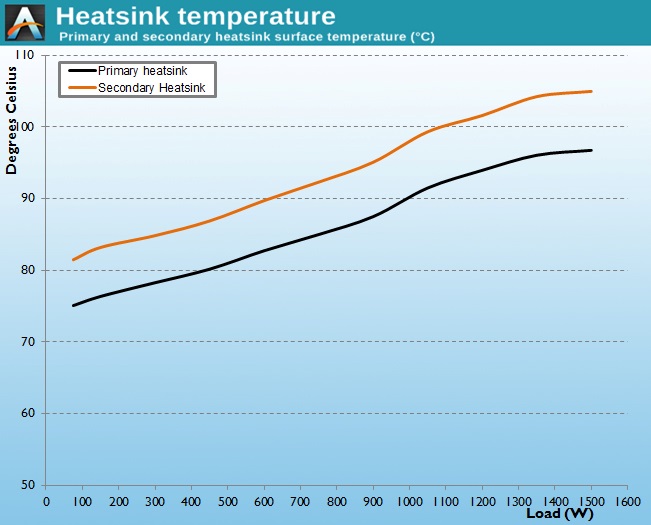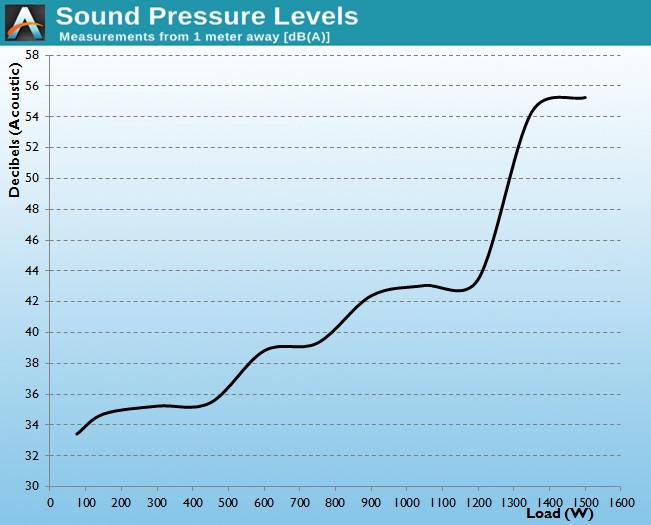The SilverStone Strider Gold S 1500W PSU Review
by E. Fylladitakis on April 7, 2015 8:00 AM EST- Posted in
- Cases/Cooling/PSUs
- PSUs
- SilverStone
- 1500W
Hot Test Results
As it can be seen in the following tables, SilverStone's currently most powerful PSU does offer outstanding power quality, especially if the massive power output is taken into account. The maximum voltage ripple on the 12V line is just 30mV at maximum load, under an outrageous current draw of nearly 110A. Ripple suppression is equally great on the minor voltage lines as well. Voltage regulation is a little more complicated, as the stability of the 12V line is amazing, with a change of less than 1% across the load range. However, the regulation of the 3.3V/5V lines is a lot less tight, at 2%/2.4% respectively.
| Main Output | ||||||||
| Load (Watts) | 303.02 W | 755.8 W | 1127.97 W | 1498.98 W | ||||
| Load (Percent) | 20.2% | 50.39% | 75.2% | 99.93% | ||||
| Line | Amperes | Volts | Amperes | Volts | Amperes | Volts | Amperes | Volts |
| 3.3 V | 4.55 | 3.39 | 11.38 | 3.38 | 17.07 | 3.34 | 22.76 | 3.33 |
| 5 V | 4.55 | 5.15 | 11.38 | 5.14 | 17.07 | 5.04 | 22.76 | 5.02 |
| 12 V | 21.85 | 12.09 | 54.63 | 12.06 | 81.94 | 12.02 | 109.26 | 11.98 |
| Voltage Ripple (mV) | |||||||
| Line | Regulation (20% to 100% load) |
||||||
| 20% Load |
50% Load |
75% Load |
100% Load |
CL1 12V |
CL2 3.3V + 5V |
||
| 3.3V | 2% | 6 | 8 | 14 | 20 | 10 | 26 |
| 5V | 2.4% | 6 | 10 | 16 | 24 | 10 | 30 |
| 12V | 0.9% | 8 | 16 | 22 | 30 | 34 | 16 |
Once again, we need to mention that this is a PSU rated at 40°C and we perform our testing at temperatures higher than 45°C - we could reduce the ambient temperature of our hotbox testing but we chose not to do so as the results would then not be comparable to those of our previous reviews.
According to these results, it becomes apparent that SilverStone is most likely just playing it safe regarding the 40°C rating for continuous operation. High ambient temperatures had little effect on the performance of the ST1500-GS, reducing its energy conversion efficiency by an average of just 0.3%. The maximum efficiency is reduced to 91.6% at exactly half load.
High temperatures are to be expected from a PSU with this kind of power output and the ST1500-GS does get terribly warm when fully loaded under these conditions. Do note however that the probe that is taking our secondary side readings is now sandwiched between the thermal pad and the chassis (that acts as the main secondary side heatsink), meaning that the readings are naturally higher than with other models. The cooling fan once again follows a "stepping" speed model - the only difference is that now the fan jumps up to maximum RPM at 90% load, correctly abandoning every notion of acoustic comfort to ensure reliability.















32 Comments
View All Comments
ShieTar - Thursday, April 9, 2015 - link
The Powercolor Devil13 (2x R9 290X) can pull loads in excess of 450W (and clear excess of the ATX specifications), so a crossfire setup with two of those and an AMD FX-9590 can exceed 1100W on CPU & GPU alone. Add Memory and a bunch of Harddrives, and maybe a dozen electronic gadgets on the USB ports, and you can use the 1500kW in extreme load cases.Not saying you should, an Intel 2011-3 system with two Titan X will give you more gaming power in barely over 600W peak power consumption.
Oxford Guy - Thursday, April 9, 2015 - link
One overclocked 290X hit 400 watts in Tom's testing. It was only a very brief spike, but those spikes should be factored in. So, three of those plus a 9590 and you're talking 1465 watts.jabber - Tuesday, April 7, 2015 - link
Handy review for the three or four that might need this.sweeper765 - Tuesday, April 7, 2015 - link
I would appreciate a different direction from the psu makers.With today's low power systems idling at 15-30W it would make more sense to focus on low load efficiency and smaller total power output, while maintaining the same quality components found in higher powered models.
darkfalz - Tuesday, April 7, 2015 - link
That describes most PSUs actually sold. The one in this review is strictly for e-peen who devote far too much of their income to their PCs.Samus - Tuesday, April 7, 2015 - link
People always overbuild their PSU's. They go for watts over quality. It's a consumer misunderstanding of power requirements and efficiency.Most OEM systems come with ~200-watt PSU's these days. Even high-end workstations like HP Z and Dell Precisions have 280-watt PSU's.
My Xeon workstation with a GTX970 has a 400-watt PSU and my Overclocked i7 SLI gaming PC has a 550-watt PSU, and both have headroom (peak draw from the wall for each under OCCT\furmark is 363-watts and 509-watts.)
I'm not saying a product like this has no reason to exist, but let's just say it's for "the 1%."
DanNeely - Wednesday, April 8, 2015 - link
The most recent 80+ spec, Titantium does focus on low load efficiency by requiring 90% efficiency at a 10% load. For all but the most severe cases of mis-matched system power and PSU size this will bring idle loads for systems with dGPUs into the high efficiency operating range.If OEMs actually refresh their low power models the same should be possible for IGP only boxes; but the negligible number of 80+ units of any size in that range make me suspect we'll be waiting a while for that to happen. Accommodating Haswell's deeper sleep states might push more of them to refresh their designs over the next year or two; but only 9/23 haswell compatable <400W models on newegg are gold certified (none are platinum). However the additional 432 non-haswell certified PSUs in that power bracket make it clear that this is going to be a very slow process. TBH for those systems actual amounts of power saved are small enough that it's only at very high power prices that a high efficiency PSU will pay for itself over a reasonable time horizon. Unless forced by regulators, I wouldn't hold my breath for any significant movement in the small PSU segment.
darkfalz - Tuesday, April 7, 2015 - link
Fools and their money hey... there are some people who purchase merely for the wattage number on the PSU. Says nothing of the quality and even less of the actual requirement. I wonder if this was a hangover from the days where a cheap 300W POS, er PSU would struggle to output 200W without exploding. I peaked 350 watts with a pretty hefty system (GTX 680, overclocked i5-3570K, 2 HDDs). That's 250 watts of headroom from my "low end" 600W PSU. Things might be different in AMD world but Intel/NVIDIA just keep getting more and more PPW.reininop - Tuesday, April 7, 2015 - link
I didn't read the full article, so I may be restating, but for all the people asking what you need 1500W for, the efficiency of these usually peaks at about 50 - 70% of rated power if I remember right. While even a 750 W pull is a pretty hefty system, there might be a slight market for the eco-conscious tech enthusiast...Okay, so maybe the audience is still only about 4 people.
DanNeely - Tuesday, April 7, 2015 - link
You obviously didn't read much if any of the article: You're way off.This is an 80+ gold unit which means that it needs to be >88% efficiency from 20-100% of full load (@220v, >87% at 110). It managed >90, and peaked at 92% efficient at a 50% load.
Sub 70% efficient power supplies are designs from a decade or more ago; and are long gone from the market (possibly excepting some of the sketchiest no-name models); bargain basement 80+ units are widely available now.
Lastly, the power rating is output power, not input. A hypothetical 50% efficient 1500W PSU would still output 1500W of power; it would however draw 3000W at the intake.